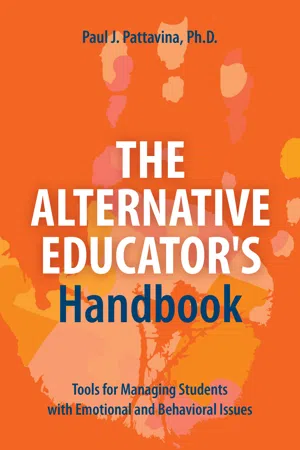
The Alternative Educator's Handbook
Tools for Managing Students with Emotional and Behavioral Issues
- 212 pages
- English
- ePUB (mobile friendly)
- Available on iOS & Android
The Alternative Educator's Handbook
Tools for Managing Students with Emotional and Behavioral Issues
About this book
The Alternative Educator's Handbook, by Dr. Paul J. Pattavina, is a comprehensive, practical collection of strategies and researched practices to be implemented with students who present social, emotional and behavioral challenges in school. It is a handbook intended to serve as a practical resource for teachers and staff who work with students whose progress in school is interrupted by social and emotional issues – kids who tend to, either intentionally or unintentionally, 'pluck your last nerve'. It reviews student characteristics and intervention procedures, as well as specific forms and procedures created or adapted over time and experience. The ideas in this book will serve as a guide for educators and mental health professionals who are responsible for these kinds of difficult students, in whatever educational setting they might be placed - alternative schools or programs, private clinical or therapeutic schools, intensive behavior support classrooms or flexible resource room classrooms in public schools. This is a book that should be read by special and regular education teachers, school social workers, counselors, clinicians and school psychologists; paraprofessionals and child care workers; principals and assistant principals; school superintendents and board of education members; juvenile probation officers; parents and concerned community members; and college instructors who train special education teachers.The need for effective, alternative programs for students with challenging emotional and behavior patterns continues to be a pressing issue for public schools nationwide. The concern has been exacerbated in the past several years by continued school shootings and violence, creating a grave sense of fear among students, parents and staff, by the actions of kids with guns and other weapons in school. Legislators and public officials have been called to take actions that will keep kids safer in school, focusing particularly on gun control, limiting access and adding guards. And although such measures will be essential towards preventing some school violence, the kinds of programming and resources available for our public schools must also be closely examined. In effect, schools will need to find ways to identify and provide programming options for students who may be disgruntled, alienated, unconnected, impulsive, and who may be looking to be recognized, seek revenge or put an end to bullying, perceived harassment, injustice or a life of ignominy--kids who feel they have nothing left to lose. Companion files for use with the book are posted below.
BrownWalker.com/download/Pattavina-OnlineAppendix.pdf
BrownWalker.com/download/Pattavina-PowerPoint.zip
BrownWalker.com/download/Pattavina-Spreadsheet.zip
Frequently asked questions
- Essential is ideal for learners and professionals who enjoy exploring a wide range of subjects. Access the Essential Library with 800,000+ trusted titles and best-sellers across business, personal growth, and the humanities. Includes unlimited reading time and Standard Read Aloud voice.
- Complete: Perfect for advanced learners and researchers needing full, unrestricted access. Unlock 1.4M+ books across hundreds of subjects, including academic and specialized titles. The Complete Plan also includes advanced features like Premium Read Aloud and Research Assistant.
Please note we cannot support devices running on iOS 13 and Android 7 or earlier. Learn more about using the app.
Information
%20to%20Behavior.pdf.
- clear behavioral expectations,
- systemic ways to encourage appropriate behavior,
- systemic ways to discourage inappropriate behavior,
- ways to teach appropriate behavior and social skills,
- a method to monitor effectiveness, including data-driven decision-making practices.
Table 3 Tier One Teaching Practices |
–Expected student behavior and routines in classroom(s) are stated positively and defined clearly. –Problem behaviors are defined clearly. –Expected student behavior and routines are taught directly. –Expected student behaviors acknowledged regularly (i.e., positively reinforced at 4:1 ratio of positive to negative comments). –Problem behaviors receive consistent consequences. –Procedures for expected and problem behaviors are consistent with school-wide procedures. –Classroom-based options exist to allow classroom instruction to continue when problem behavior occurs. –Instruction and curriculum materials are matched to student ability (math, reading, language). –Students experience high rates of academic success daily (> 75% correct). –Teachers have regular opportunities for access to assistance and support (e.g., observation, professional staff development, coaching). –Transitions between instructional an... |
Table of contents
- Cover Page
- Half Title
- Full Title
- Copyright
- Table of Contents
- Acknowledgements
- Introductory Notes
- Foreword
- Preface
- I. Introduction
- II. STUDENTS WITH CHALLENGING EMOTIONAL AND BEHAVIORAL ISSUES
- III. BACKGROUND MODELS AND RESEARCH
- IV. RECOMMENDED PRACTICES
- Bibliography